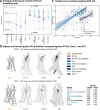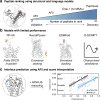Deep learning in GPCR drug discovery: benchmarking the path to accurate peptide binding
- PMID: 40285358
- PMCID: PMC12031724
- DOI: 10.1093/bib/bbaf186
Deep learning in GPCR drug discovery: benchmarking the path to accurate peptide binding
Abstract
Deep learning (DL) methods have drastically advanced structure-based drug discovery by directly predicting protein structures from sequences. Recently, these methods have become increasingly accurate in predicting complexes formed by multiple protein chains. We evaluated these advancements to predict and accurately model the largest receptor family and its cognate peptide hormones. We benchmarked DL tools, including AlphaFold 2.3 (AF2), AlphaFold 3 (AF3), Chai-1, NeuralPLexer, RoseTTAFold-AllAtom, Peptriever, ESMFold, and D-SCRIPT, to predict interactions between G protein-coupled receptors (GPCRs) and their endogenous peptide ligands. Our results showed that structure-aware models outperformed language models in peptide binding classification, with the top-performing model achieving an area under the curve of 0.86 on a benchmark set of 124 ligands and 1240 decoys. Rescoring predicted structures on local interactions further improved the principal ligand discovery among decoy peptides, whereas DL-based approaches did not. We explored a competitive tournament approach for modeling multiple peptides simultaneously on a single GPCR, which accelerates the performance but reduces true-positive recovery. When evaluating the binding poses of 67 recent complexes, AF2 reproduced the correct binding modes in nearly all cases (94%), surpassing those of both AF3 and Chai-1. Confidence scores correlate with structural binding mode accuracy, which provides a guide for interpreting interface predictions. These results demonstrated that DL models can reliably rediscover peptide binders, aid peptide drug discovery, and guide the selection of optimal tools for GPCR-targeted therapies. To this end, we provided a practical guide for selecting the best models for specific applications and an independent benchmarking set for future model evaluation.
Keywords: AlphaFold; GPCR; RoseTTAFold; docking; peptide receptor; structure prediction.
© The Author(s) 2025. Published by Oxford University Press.
Figures





Similar articles
-
Benchmarking GPCR homology model template selection in combination with de novo loop generation.J Comput Aided Mol Des. 2020 Oct;34(10):1027-1044. doi: 10.1007/s10822-020-00325-x. Epub 2020 Jul 31. J Comput Aided Mol Des. 2020. PMID: 32737667 Free PMC article.
-
How accurately can one predict drug binding modes using AlphaFold models?Elife. 2023 Dec 22;12:RP89386. doi: 10.7554/eLife.89386. Elife. 2023. PMID: 38131311 Free PMC article.
-
Multi-state modeling of G-protein coupled receptors at experimental accuracy.Proteins. 2022 Nov;90(11):1873-1885. doi: 10.1002/prot.26382. Epub 2022 May 16. Proteins. 2022. PMID: 35510704 Free PMC article.
-
Artificial Intelligence: A New Tool for Structure-Based G Protein-Coupled Receptor Drug Discovery.Biomolecules. 2025 Mar 17;15(3):423. doi: 10.3390/biom15030423. Biomolecules. 2025. PMID: 40149959 Free PMC article. Review.
-
Molecular interaction fingerprint approaches for GPCR drug discovery.Curr Opin Pharmacol. 2016 Oct;30:59-68. doi: 10.1016/j.coph.2016.07.007. Epub 2016 Jul 29. Curr Opin Pharmacol. 2016. PMID: 27479316 Review.
References
MeSH terms
Substances
Grants and funding
LinkOut - more resources
Full Text Sources

